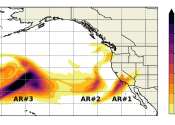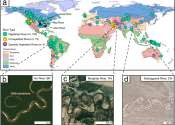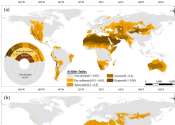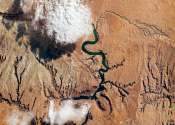How NASA spotted El Niño changing the saltiness of coastal waters
New findings have revealed a coastal realm highly sensitive to changes in runoff and rainfall on land.

New findings have revealed a coastal realm highly sensitive to changes in runoff and rainfall on land.
Earth Sciences
Apr 3, 2024
0
161

In California's 2022-2023 winter season, the state faced nine atmospheric rivers (ARs) that led to extreme flooding, landslides, and power outages—the longest duration of continuous AR conditions in the past 70 years. Scientists ...
Earth Sciences
Apr 18, 2024
1
84

Herds of endangered hippos stuck in the mud of dried-up ponds are in danger of dying in drought-struck Botswana, conservation authorities told AFP Friday.
Environment
Apr 26, 2024
0
46

Another study refutes the belief that Las Vegas and other urban centers in the Southwest are sucking Lake Mead dry. Instead, if the region is to adequately address its water problems, policymakers must confront hard questions ...
Earth Sciences
Apr 3, 2024
0
2

Just as water moves through a river, rivers themselves move across the landscape. They carve valleys and canyons, create floodplains and deltas, and transport sediment from the uplands to the ocean.
Earth Sciences
Apr 25, 2024
0
53

Plumbing problems at the dam holding back the second-largest reservoir in the U.S. are spurring concerns about future water delivery issues to Southwestern states supplied by the Colorado River.
Environment
Apr 17, 2024
0
4

Oases are important habitats and water sources for dryland regions, sustaining 10% of the world's population despite taking up about 1.5% of land area. But in many places, climate change and anthropogenic activities threaten ...
Earth Sciences
Apr 22, 2024
0
41

Environmentalists rejoiced when China announced its commitment to reach carbon neutrality by 2060, but the decarbonization of China—which emits 27% of global carbon dioxide and a third of the world's greenhouse gases—may ...
Earth Sciences
Apr 29, 2024
0
23

A study led by NASA researchers provides new estimates of how much water courses through Earth's rivers, the rates at which it's flowing into the ocean, and how much both of those figures have fluctuated over time—crucial ...
Earth Sciences
Apr 29, 2024
0
8

An analysis of glacial data spanning four decades has provided valuable insights into the changes taking place in the glaciers of the Pir Panjal range within the Kashmir basin in India. The research, published in the International ...
Earth Sciences
Apr 9, 2024
0
41
A river is a natural watercourse, usually freshwater, flowing toward an ocean, a lake, a sea or another river. In a few cases, a river simply flows into the ground or dries up completely before reaching another body of water. Small rivers may also be called by several other names, including stream, creek, brook, rivulet, and rill; there is no general rule that defines what can be called a river. Many names for small rivers are specific to geographic location; one example is Burn in Scotland and North-east England. Sometimes a river is said to be larger than a creek, but this is not always the case, due to vagueness in the language.
A river is part of the hydrological cycle. Water within a river is generally collected from precipitation through surface runoff, groundwater recharge, springs, and the release of stored water in natural ice and snowpacks (i.e., from glaciers).
This text uses material from Wikipedia, licensed under CC BY-SA